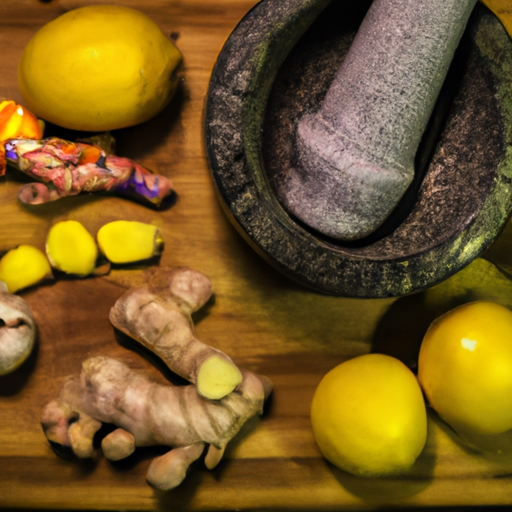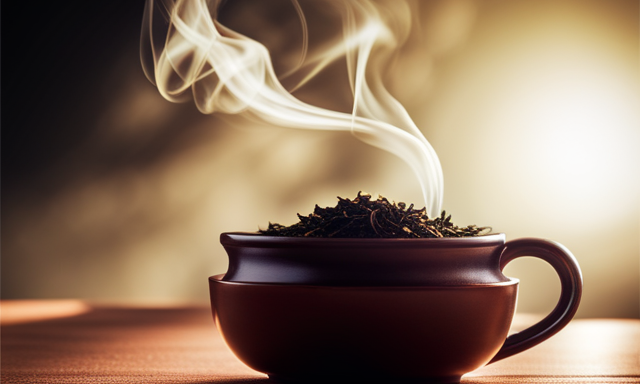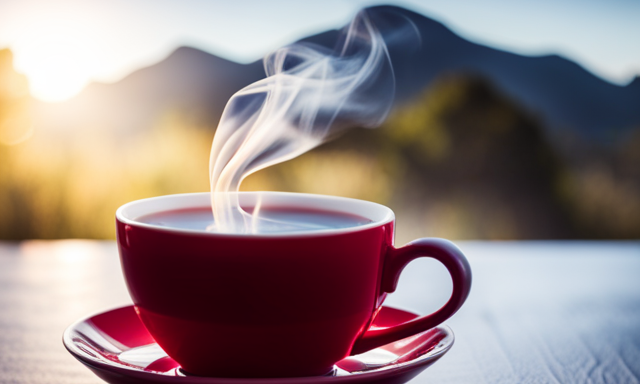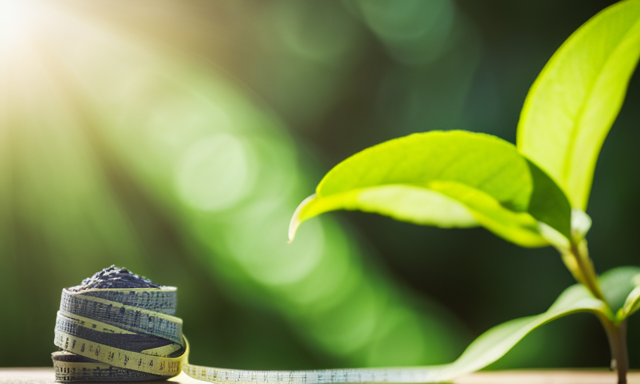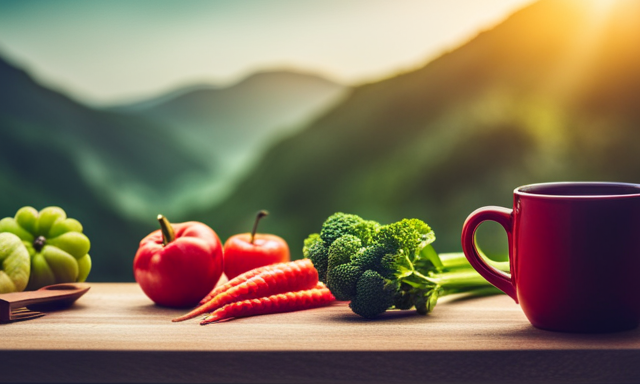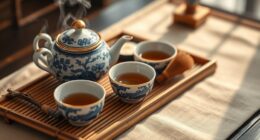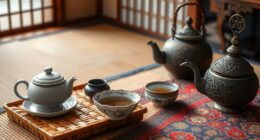As a tea enthusiast, I have always been captivated by the rich history and diverse flavors of oolong tea. Steeping a cup of this exquisite brew is like embarking on a sensory journey, where the leaves unfurl and release their unique aromas, enticing both the palate and the mind.
Oolong tea, known for its semi-oxidized leaves, has a fascinating origin that can be traced back to ancient China. It was later introduced to Taiwan, where it found its own distinct character and processing methods.
In this article, we will delve into the historical origins of oolong tea, explore its different types and varieties, and uncover its cultural significance through the traditional tea ceremonies. Additionally, we will discuss the growing popularity of oolong tea in the West and the sustainable farming practices employed in its production.
So join me as we unravel the secrets of oolong tea and discover the remarkable journey of where it truly comes from.
Key Takeaways
- Oolong tea originated in China during the Ming Dynasty and was later introduced to Taiwan, where it is known for producing the finest oolong teas in the world.
- Oolong tea has a unique processing method that involves partial oxidation, resulting in a nuanced and complex flavor profile ranging from floral and fruity to toasty and nutty.
- There are various types and varieties of oolong tea, each with its own distinct flavor profile and aroma, such as Tie Guan Yin, Da Hong Pao, Oriental Beauty, and Milk Oolong.
- Oolong tea is not only enjoyed for its taste but also offers health benefits, including boosting metabolism, supporting heart health, enhancing mental alertness, and supporting digestion. It is also deeply rooted in Asian culture and celebrated for its beauty and artistry.
Historical Origins of Oolong Tea in China
Oolong tea originated in China during the Ming Dynasty. Its historical significance cannot be overstated, as it has become an integral part of Chinese cultural traditions.
Oolong tea was first cultivated in the Fujian province, where the unique climate and soil conditions created the perfect environment for tea production. The Ming Dynasty saw the rise of tea masters who perfected the art of oolong tea-making, developing various techniques to enhance its flavor and aroma.
Oolong tea quickly gained popularity among the Chinese elite and became a symbol of sophistication and refinement. This rich history and cultural significance laid the foundation for the introduction of oolong tea to Taiwan, where it would flourish and develop its own unique character.
Introduction of Oolong Tea to Taiwan
When it comes to introducing oolong tea to Taiwan, there’s a fascinating story about how this beloved beverage made its way to the island.
The origins of oolong tea can be traced back to China, but it was in the 19th century that a Fujianese tea master named Wu Liang discovered the ideal climate and soil conditions in Taiwan for cultivating oolong tea. This discovery led to the introduction of oolong tea to Taiwan and the establishment of tea plantations in the high mountains of the island.
Today, Taiwan is known for producing some of the finest oolong teas in the world, with its unique terroir and traditional tea-making techniques. This rich history and expertise in oolong tea production have made Taiwan a renowned destination for tea enthusiasts worldwide.
Now, let’s delve into the next section about oolong tea’s unique processing method.
Oolong Tea’s Unique Processing Method
The intricate processing method of oolong tea unveils the delicate balance between oxidation and fermentation, resulting in a nuanced and complex flavor profile. Oolong tea’s oxidation process is what sets it apart from other types of tea. It undergoes partial oxidation, meaning it is somewhere between green tea (unoxidized) and black tea (fully oxidized). This unique process gives oolong tea its distinctive flavor profiles, which can range from floral and fruity to toasty and nutty. To better understand the different flavor profiles, let’s take a look at a comparison table:
| Flavor Profile | Description |
|---|---|
| Floral | Light and fragrant, with notes of flowers and honey |
| Fruity | Sweet and refreshing, with hints of tropical fruits |
| Toasty | Rich and toasty, with a caramelized aroma |
As we delve into the different types and varieties of oolong tea, we will explore how the oxidation process and other factors contribute to these diverse flavors.
Different Types and Varieties of Oolong Tea
Let’s now discover the wide array of oolong tea varieties and explore the unique characteristics they offer.
Oolong tea is produced in various regions, each imparting its own distinct flavor profile and aroma. Here are some different types and varieties of oolong tea to try:
-
Tie Guan Yin: This oolong tea from China is known for its floral and orchid-like aroma. It is best brewed using the gongfu cha method, which involves multiple short infusions.
-
Da Hong Pao: Originating from the Wuyi Mountains in China, this oolong tea boasts a roasted flavor with hints of chocolate and a rich, earthy aroma. It is traditionally brewed using the Yixing teapot.
-
Oriental Beauty: Grown in Taiwan, this unique oolong tea is made from leaves that have been bitten by small green leafhoppers. It offers a sweet, fruity taste and is best brewed using the steep-and-pour method.
-
Milk Oolong: This tea, also known as Jin Xuan, is famous for its creamy and smooth texture. It is grown in Taiwan and can be brewed using various techniques, such as gongfu style or regular steeping.
Now that we have explored the different types and varieties of oolong tea, let’s delve into the fascinating world of its flavor profile and aroma.
Flavor Profile and Aroma of Oolong Tea
Get ready to embark on a flavorful journey with oolong tea as you savor its aromatic notes and indulge in its rich taste. Oolong tea offers a wide range of flavor profiles, making it a versatile and enjoyable beverage for tea enthusiasts. Its taste can vary from floral and fruity to toasty and nutty, depending on the specific type and level of oxidation. To fully appreciate the nuances of oolong tea, it is important to use the right brewing techniques. The water temperature and steeping time can greatly impact the flavor and aroma of the tea. Experimenting with different brewing methods can unlock the full potential of this exquisite tea. Moving forward to the health benefits of oolong tea, it is important to note its numerous advantages for overall well-being.
Health Benefits of Oolong Tea
Indulging in a cup of this aromatic beverage can provide a myriad of health benefits for your overall well-being. Here are four reasons why incorporating oolong tea into your daily routine can be beneficial:
-
Boosts metabolism: Oolong tea contains polyphenols that aid in fat oxidation and can help increase your metabolic rate.
-
Supports heart health: Regular consumption of oolong tea has been linked to a reduction in cholesterol levels, promoting a healthy heart.
-
Enhances mental alertness: The combination of caffeine and L-theanine in oolong tea can improve focus, concentration, and mental performance.
-
Supports digestion: Oolong tea has been shown to have anti-inflammatory properties that can help soothe digestive issues and promote gut health.
By understanding the health benefits and exploring different brewing techniques, you can fully appreciate the significance of oolong tea in both the ritualistic oolong tea ceremony and its cultural importance.
Oolong Tea Ceremony and Cultural Significance
After learning about the health benefits of oolong tea, it’s fascinating to delve into its cultural significance and the art of the oolong tea ceremony. In many Asian countries, this ceremony is a cherished tradition that celebrates the beauty and artistry of tea. The ceremony involves meticulous brewing techniques that have been passed down through generations, resulting in a flavorful and aromatic cup of oolong tea.
To truly appreciate the elegance of the oolong tea ceremony, it’s important to understand the health benefits associated with this tea. Oolong tea is known to promote weight loss, boost metabolism, and improve heart health. Its high levels of antioxidants can also help reduce the risk of chronic diseases.
In the table below, I have summarized some of the key health benefits and brewing techniques of oolong tea:
| Health Benefits | Brewing Techniques |
|---|---|
| Promotes weight loss | Use water that is around 190-200°F |
| Boosts metabolism | Steep the tea leaves for 3-5 minutes |
| Improves heart health | Use 1 teaspoon of tea leaves per cup |
| Reduces risk of chronic diseases | Rinse the tea leaves before steeping |
As oolong tea’s popularity continues to grow in the west, it’s important to understand its cultural significance and brewing techniques. Transitioning into the next section, let’s explore how oolong tea has captivated the taste buds of Western tea enthusiasts.
Oolong Tea’s Growing Popularity in the West
To truly understand the cultural significance of oolong tea and its growing popularity in the West, you’ll be amazed by how this traditional ceremony has captured the fascination of Western tea enthusiasts.
Oolong tea’s health benefits and cultural significance have played a significant role in its rising popularity. This unique tea is known for its ability to promote weight loss, boost metabolism, and improve digestion. Additionally, it contains antioxidants that can help reduce the risk of chronic diseases. As Western consumers become more health-conscious, they are drawn to oolong tea’s potential health benefits.
Moreover, the cultural significance of oolong tea, with its rich history and ceremonial practices, adds an air of mystique and elegance that appeals to tea lovers in the West.
Transitioning to the subsequent section, sustainable farming practices in oolong tea production play a crucial role in preserving the quality and tradition of this beloved tea.
Sustainable Farming Practices in Oolong Tea Production
Immerse yourself in the world of oolong tea production and witness the blossoming beauty of sustainable farming practices, cultivating a future as vibrant as a field of blooming flowers. Sustainable farming techniques play a crucial role in oolong tea production, ensuring the environmental impact is minimized while maintaining the highest quality of tea leaves.
Organic fertilizers: Farmers employ natural fertilizers like compost and animal manure, reducing the use of synthetic chemicals that harm the soil and surrounding ecosystems.
Integrated pest management: By implementing biological controls, such as attracting beneficial insects or using pheromone traps, farmers can effectively manage pests without resorting to harmful pesticides.
Water conservation: Through innovative irrigation methods like drip irrigation and rainwater harvesting, farmers conserve water resources and minimize wastage.
These sustainable farming practices not only preserve the natural environment but also result in healthier tea plants and superior tea quality.
Transitioning into tips for brewing and enjoying oolong tea, let’s explore the art of savoring this exquisite beverage.
Tips for Brewing and Enjoying Oolong Tea
Indulge yourself in the art of brewing and savoring the exquisite flavors of oolong tea with these expert tips.
When it comes to brewing oolong tea, the right techniques can make all the difference in the final flavor profile. Start by using high-quality loose leaf oolong tea and carefully measure out the right amount for your desired strength.
Water temperature is crucial, as oolong tea requires a slightly lower temperature than black or green tea. Aim for around 190-200°F to bring out the best flavors.
Steep the tea for 3-5 minutes, depending on your preference for strength. For a traditional experience, consider using a gaiwan or Yixing teapot to enhance the brewing process. These tea accessories can help you appreciate the delicate aromas and flavors of oolong tea to the fullest.
So, grab your favorite tea leaves, follow these brewing techniques, and enjoy a truly satisfying cup of oolong tea.
Frequently Asked Questions
How many cups of oolong tea should I drink per day for optimal health benefits?
I recommend drinking 2-3 cups of oolong tea per day for optimal health benefits. It’s important to choose reputable oolong tea brands and follow proper brewing methods to ensure the best flavor and health benefits.
Can oolong tea help with weight loss?
Oolong tea is my secret weapon for weight loss. Its metabolism-boosting properties help burn fat while improving digestion. Plus, its high levels of antioxidants protect against cell damage, giving me a healthy and slim physique.
What is the caffeine content in oolong tea compared to other types of tea?
The caffeine content in oolong tea varies depending on the specific type and brewing method, but it generally contains less caffeine than black tea but more than green tea. Oolong tea also has potential benefits for heart health.
Are there any potential side effects or risks associated with drinking oolong tea?
Drinking oolong tea has potential health benefits, but it’s important to be aware of potential side effects. While it may boost metabolism and aid in weight loss, long-term effects on health are still being studied.
Can oolong tea be enjoyed with milk or other additives?
Yes, oolong tea can be enjoyed with milk or other additives. Adding milk to oolong tea can enhance its flavor and provide additional health benefits, such as improving digestion and promoting bone health.
Conclusion
Oolong tea has a rich history and unique processing methods. Its origins in China and subsequent introduction to Taiwan have shaped its cultural significance and the way it is enjoyed today. With its growing popularity in the West, oolong tea is becoming more accessible to tea enthusiasts around the world.
From its delicate aroma to its intricate brewing process, oolong tea offers a sensory experience like no other. So why not indulge in a cup of oolong tea and embark on a flavorful journey?


